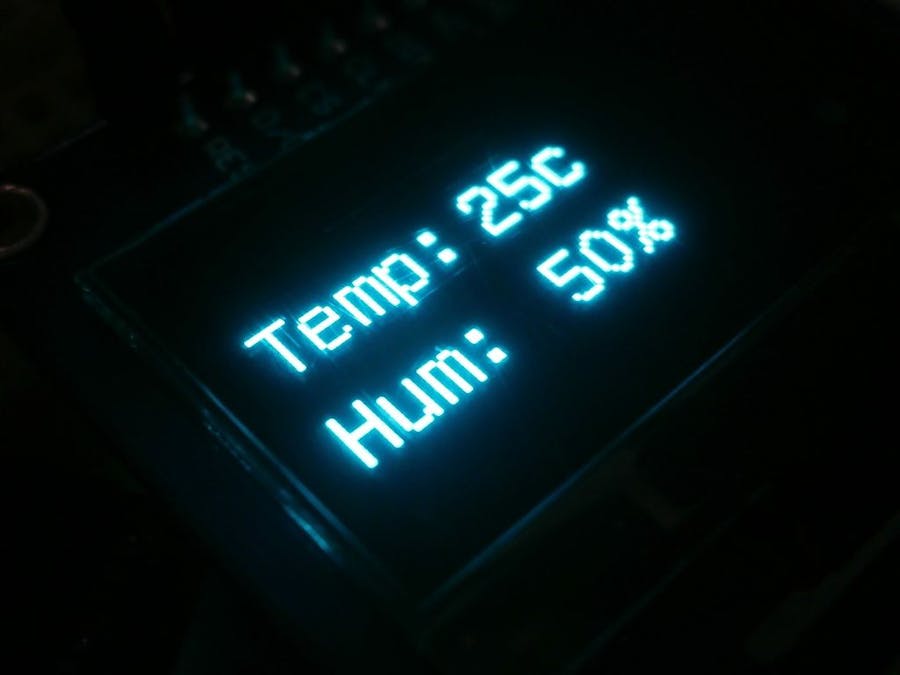Hello! I'm going to show you how to make an Arduino OLED thermometer and hygrometer* with DHT11.
The OLED we will use today is 1.3″ inch in size, features 128×64 pixels and uses the SPI Bus. On the next step you will find more useful information about the OLED tech and this display.
We will use the u8glib library to communicate with our display. This library has many available parameters with it you can display numbers, letters, bitmaps and other symbols on OLEDs and graphic LCDs also it works for E-ink displays.
* A hygrometer /haɪˈɡrɒmɨtər/ is an instrument used for measuring the moisture content in the atmosphere. - Wikipedia
Step 1: Info about the OLED display and techAn organic light-emitting diode (OLED) is a light-emitting diode (LED) in which the emissive electroluminescent layer is a film of organic compound that emits light in response to an electric current. This layer of organic semiconductor is situated between two electrodes; typically, at least one of these electrodes is transparent. - Wikipedia
The one I use is produced by Waveshare. Its 1.3″ inch in size, features 128×64 pixels and uses the 4-wire Serial Peripheral Interface Bus. It is monochrome blue in color also it consumes 0.04 W of energy which is one tenth that is required to run traditional 16x2 LCD display.
The OLED could be modified (soldering required) to communicate with different Bus, like a I2C or a 3-wire SPI, by moving one of the two resistors which can be found on the back of the display board. They are marked with 0s, check the pic above.
Changing the Bus from a 4-wire SPI to a I2C or a 3-wire SPI:
- I2C - move BS1 resistor on 1 but keep BS0 on 0 as it is.
- 3-wire SPI - BS1 must be 0 and BS0 on 1
The DHT11 is a basic, ultra low-cost digital temperature and humidity sensor. It uses a capacitive humidity sensor and a thermistor to measure the surrounding air, and spits out a digital signal on the data pin (no analog input pins needed). Its fairly simple to use, but requires careful timing to grab data. The only real downside of this sensor is you can only get new data from it once every 2 seconds, sensor readings can be up to 2 seconds old.
Features:
- Small size, low cost
- Easy to use 3 to 5V power and I/O
- 2.5mA max current use during conversion (while requesting data)
- Good for 20-80% humidity readings with 5% accuracy
- Good for 0-50°C temperature readings ±2°C accuracy
- No more than 1 Hz sampling rate (once every second)
To make it we gonna need the following stuff:
- Arduino UNO board or similar
- OLED display (1.3inch; 128x64) or similar
- DHT11 - temperature and humidity sensor
- Jumpers x 12 - to connect everything
Now take a look on the schematic above, plug in the display and the sensor into the breadboard. Then connect the negative and positive voltage pins of both DHT11 and the OLED to the ground and +5v pins of the Arduino UNO board with jumpers.
Then take one jumper and connect the output pin of the sensor to A0 of the Arduino board.
Connect the OLED pins: DIN to pin 13; CLK to pin 11; CS to pin 10; D/C to pin 9 and RES to pin 8 with the rest of the jumpers. 13, 11, 10, 9 and 8 are the SPI Bus of Arduino UNO they are also the ICSP connector under the microcontroller.
Once you connect them you can upload the code to the board (you can do that before connecting the sensor and the display).
Step 5: Upload the codeThis step is easy, just download one of the two .INO files, named Fahrenheit (measures in F) and Celsius (measures in C), and open it with the Arduino IDE then upload the code to the Arduino board.
If you don't like the current font you can change it simply by editing the code. You can find all supported fonts here.
If you don't have Arduino IDE click here to download it. Then install it.
Libraries you will need: DHT and u8glib download the libraries and then unzip them at /Program Files(x86)/Arduino/Libraries (default).
UPDATE: NOW WITH SUPPORT FOR SSD1306 128X32 AND 128X64 WITH SPI BUS. CODE FOR DUAL COLOR OLED (1/4 YELLOW, 3/4 BLUE, SSD1306) - DHT_DC_OLED_V1.26.16
Step 6: Congrats !!!Now you have an Arduino OLED thermometer and hygrometer and you can measure the temperature in Fahrenheit or in Celsius and the moisture content of the air anywhere you want.
Bitcoin tips: 1Bfgrq4dQSuRHuTdk5jzZPtnMZLymDQ5dv
Featured comments:
"It's a nice beginners project to get started with OLEDs and temperature sensors". - MaterialBall
"Thanks for the share, very easy to follow instructions!" - Akin Yildiz
"Outstanding!!" - kath65




_ztBMuBhMHo.jpg?auto=compress%2Cformat&w=48&h=48&fit=fill&bg=ffffff)










Comments
Please log in or sign up to comment.